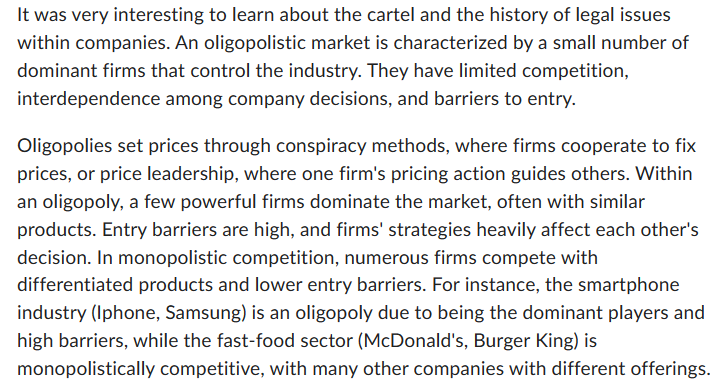Question
scenario 1) Oligopolies are markets where a few firms like Walmart and HyVee control the market. Oligopolies set their prices by using game theory, they

scenario 1)
Oligopolies are markets where a few firms like Walmart and HyVee control the market. Oligopolies set their prices by using game theory, they are trying to guess what the competition will do. When firms come together to control market price, it is called collusion, is illegal, and is punishable by law. In a monopolistic competitive market, multiple firms are competing for price, which generally forces prices to hit the equilibrium, in an oligopoly a few firms are controlling the market. Starbucks would be a firm that would be in monopolistic competition, they have competition but people are willing to go to them and pay their prices because of marketing and other contributing factors.
Scenario 2)
It was very interesting to learn about the cartel and the history of legal issues within companies. An oligopolistic market is characterized by a small number of dominant firms that control the industry. They have limited competition, interdependence among company decisions, and barriers to entry.
Oligopolies set prices through conspiracy methods, where firms cooperate to fix prices, or price leadership, where one firm's pricing action guides others. Within an oligopoly, a few powerful firms dominate the market, often with similar products. Entry barriers are high, and firms' strategies heavily affect each other's decision. In monopolistic competition, numerous firms compete with differentiated products and lower entry barriers. For instance, the smartphone industry (Iphone, Samsung) is an oligopoly due to being the dominant players and high barriers, while the fast-food sector (McDonald's, Burger King) is monopolistically competitive, with many other companies with different offerings
Based on the two scenarios above provide examples from the news of oligopolistic markets. Compare and contrast with examples of monopolistic competitive markets.
It was very interesting to learn about the cartel and the history of legal issues within companies. An oligopolistic market is characterized by a small number of dominant firms that control the industry. They have limited competition, interdependence among company decisions, and barriers to entry. Oligopolies set prices through conspiracy methods, where firms cooperate to fix prices, or price leadership, where one firm's pricing action guides others. Within an oligopoly, a few powerful firms dominate the market, often with similar products. Entry barriers are high, and firms' strategies heavily affect each other's decision. In monopolistic competition, numerous firms compete with differentiated products and lower entry barriers. For instance, the smartphone industry (Iphone, Samsung) is an oligopoly due to being the dominant players and high barriers, while the fast-food sector (McDonald's, Burger King) is monopolistically competitive, with many other companies with different offerings.
Step by Step Solution
3.45 Rating (155 Votes )
There are 3 Steps involved in it
Step: 1
Certainly Here are examples from the news that highlight oligopolistic markets and monopolistically ...
Get Instant Access to Expert-Tailored Solutions
See step-by-step solutions with expert insights and AI powered tools for academic success
Step: 2

Step: 3

Ace Your Homework with AI
Get the answers you need in no time with our AI-driven, step-by-step assistance
Get Started


